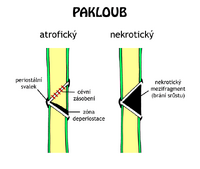Knock-on
A knock-on (pseudoarthrosis) is characterized as a disorder of fracture healing, when bone fragments do not fuse together even in a time twice as long as the normal course of healing (until then, we are only talking about ''prolonged healing'').
The fracture line is filled with fiber and surrounded by a fibrous sheath, that contains fluid.
Classification according to clinical findings[edit | edit source]
- weak: unstable, with great pathological mobility, cannot bear loads
- strong: without pathological momentum, withstands loads
Classification according to Čech and Weber[edit | edit source]
- Vital – insufficient stabilization and immobilization of the fracture, sufficient blood supply and tendency to healing.
- Hypertrophic;
- Normotrophic – occurs mostly in unstable osteosyntheses;
- Oligotrophic – usually arises from overextended skeletal traction.
- Vital – insufficient blood supply, sclerotization or osteoporosis of bone ends.
- Dystrophic;
- necrotic;
- defective;
- atrophic.
The most serious form is an infected joint – it occurs in all the above-mentioned forms and can lead to limb amputation. A special example is the tibial joint in fractures of the lower leg, where the fibula heals earlier and acts as a spacer (similarly, earlier healing of the ulna acts in fractures of the radius).
Links[edit | edit source]
[edit | edit source]
Source[edit | edit source]
- PASTOR, Jan. Langenbeck's medical web page [online]. [cit. 12.4.2010]. <https://langenbeck.webs.com/>.


